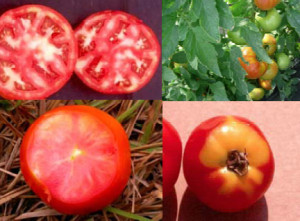Temperature management is one of the most critical factors in successful production of many high tunnel crops. While raising the minimum temperature is important, keeping the maximum temperature from exceeding a range optimum for crop growth is equally important. Since high tunnels are passively vented through sidewalls and endwalls, air temperature and humidity can affect crop growth, nutrient and water uptake, pollination, fruit ripening and pest outbreaks.
Table 1. Critical temperatures for select high tunnel crops.
| Crop | Growth stage | Optimum temperature (°F) |
Maximum temperature (°F) |
Threshold temperature for venting (°F) |
| Tomato | Transplant-flowering | 70-75°F | 85°F | 75°F |
| Flowering-harvest | 70-75°F | 85°F | 65°F | |
| Pepper | Transplant-flowering | 70-80°F | 85°F | 75°F |
| Flowering-harvest | 70-80°F | 90°F | 75°F | |
| Eggpant | Transplant-flowering | 70-85°F | 95°F | 80°F |
| Flowering-harvest | 70-85°F | 95°F | 80°F | |
| Curcurbits | Transplant-flowering | 70-85°F | 90°F | 80°F |
| Flowering-harvest | 75-85°F | 90°F | 80°F | |
| Leafy Greens | Seeding-harvest | 60-65°F | 75°F | 55°F |
| Stawberry | Fall Planting | 55-70°F | 75°F | 60°F |
| Spring Harvest | 65-75°F | 75°F | 60°F | |
| Blackberry | Fall Harvest | 70-80°F | 90°F | 90°F |
| Raspberry | Fall Harvest | 60-75°F | 80°F | 75°F |
The optimal temperature for growth of tomatoes is 70-75°F, and the minimum temperature should be greater than 55°F. Temperatures higher than 90°F day/70°F night will be detrimental to most tomato cultivars. Heat set cultivars of tomatoes are available and include: ‘Bella Rosa’, ‘Sunsation’, ‘Sunbeam’, ‘Sebring’, ‘Solar Fire’, ‘Phoenix’, ‘Talladega’ and ‘Florida 91’. Excessive temperatures can cause flower abortion, pollen sterility and ripening disorders which severely reduces marketable yield of tomatoes. Yellow shoulder disorder (Figure 1) is exacerbated by very light intensity and air temperatures.
Figure 1. Yellow shoulder disorder (YSD) of tomatoes is exacerbated by high air temperatures. Shade cloth (30-50%) can reduce YSD.
Proper design and venting of the high tunnel can prevent buildup of heat. Larger high tunnels which enclose a larger volume of air do not increase in temperature as rapidly as smaller structures during the day. Higher sidewalls facilitate cross-ventilation which is effective for reducing heat and humidity. High tunnel sidewalls should be 5 feet or greater. A ridge or peak vent will evacuate heat effectively from the top of the high tunnel.
Shade fabric (30-50%) will lower air temperatures within the high tunnel by as much as 5-8°F, and can be placed on the high tunnel when temperatures become warm. Depending on region of the U.S, the shade fabric will reduce light intensity and air temperatures. Shade fabric will also reduce water and nutrient uptake by tomato plants. The fabric can be placed on the high tunnel when the ambient (outside) air temperatures exceed a maximum of 85°F.
Peppers thrive in warm air and soil temperatures, but excessive air temperatures and light intensity can reduce yield. Eggplants and hot peppers are more tolerant of high temperatures than sweet peppers. Oriental eggplants can tolerate higher temperatures more than traditional bell-shaped eggplants. Pollen formation in pepper is reduced at temperatures above 85°F. Shade fabric will reduce sunscald of peppers and increase marketable yield.
Evaporative cooling with mist nozzles can be used to keep leafy greens cool during hot weather. Using cool water to keep the root zone cool will facilitate production of leafy greens during the summer. Static float beds placed in the high tunnel in which lettuce is grown in plugs on Styrofoam mats floating on nutrient solutions has proven to be very efficient for year-round lettuce production.
Lewis W. Jett is a State Extension Vegetable & Small Fruit Crops Specialist for West Virginia University






